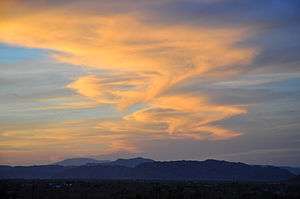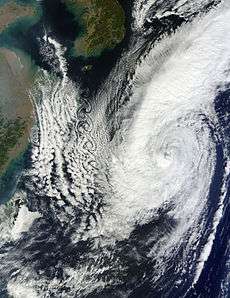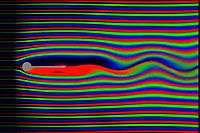Kármán vortex street
In fluid dynamics, a Kármán vortex street (or a von Kármán vortex sheet) is a repeating pattern of swirling vortices caused by the unsteady separation of flow of a fluid around blunt bodies. It is named after the engineer and fluid dynamicist Theodore von Kármán,[1] and is responsible for such phenomena as the "singing" of suspended telephone or power lines, and the vibration of a car antenna at certain speeds.
Analysis


A vortex street will only form at a certain range of flow velocities, specified by a range of Reynolds numbers (Re), typically above a limiting Re value of about 90. The Reynolds number is a measure of the ratio of inertial to viscous forces in the flow of a fluid and may be defined as:
where:
 = the diameter of the cylinder (or some other suitable measure of width of non-circular bodies) about which the fluid is flowing.
= the diameter of the cylinder (or some other suitable measure of width of non-circular bodies) about which the fluid is flowing. = the steady velocity of the flow upstream of the cylinder.
= the steady velocity of the flow upstream of the cylinder. = the kinematic viscosity of the fluid.
= the kinematic viscosity of the fluid.
or:
where:
 = the free stream fluid density.
= the free stream fluid density. = the steady free stream velocity of the flow upstream of the cylinder.
= the steady free stream velocity of the flow upstream of the cylinder. = the diameter of the cylinder (or some other suitable measure of width of non-circular bodies) about which the fluid is flowing.
= the diameter of the cylinder (or some other suitable measure of width of non-circular bodies) about which the fluid is flowing. = the free stream dynamic viscosity of the fluid.
= the free stream dynamic viscosity of the fluid.
The range of Re values will vary with the size and shape of the body from which the eddies are being shed, as well as with the kinematic viscosity of the fluid. Over a large Re range (47<Re<105 for circular cylinders) eddies are shed continuously from each side of the body, forming rows of vortices in its wake. The alternation leads to the core of a vortex in one row being opposite the point midway between two vortex cores in the other row, giving rise to the distinctive pattern shown in the picture. Ultimately, the energy of the vortices is consumed by viscosity as they move further down stream, and the regular pattern disappears.
When a single vortex is shed, an asymmetrical flow pattern forms around the body and changes the pressure distribution. This means that the alternate shedding of vortices can create periodic lateral (sideways) forces on the body in question, causing it to vibrate. If the vortex shedding frequency is similar to the natural frequency of a body or structure, it causes resonance. It is this forced vibration that, at the correct frequency, causes suspended telephone or power lines to "sing" and the antenna on a car to vibrate more strongly at certain speeds.
In meteorology

Observations of mountains and islands known to cause a Kármán vortex street
Winds blowing past isolated islands or mountains that project into the atmosphere can cause a huge vortex street disturbance downwind of them, visible in satellite photographs such as the gallery below. The following is a list of islands and mountains worldwide known to cause the Von Kármán vortex street.
- Guadalupe Island – known to cause the Von Kármán vortices, usually in May–September. It is an active island in generating the phenomenon, with a vortex street appearing almost every day in June to August.[2]
- Hallasan Volcano, Jeju Island, South Korea –Known to cause one of the world's largest Von Karman vortex streets, every winter, usually starting from October to April.[3]
- Yakushima Island, Japan[4]
- Socorro Island, a small volcanic island in the Revillagigedo Islands, a possession of Mexico – the small, 37.4 km2 island often causes long, small vortex streets downwind.[5]
- All Canary Islands[6]
- Madeira Island[7]
- Most of Cape Verde Islands[8]

- Beerenberg Volcano, Jan Mayen island.[9][10]
- Herald Island, Russia – with only 364 meters height, the small, 11.3 km2 island is one of the smallest known to cause a vortex street every summer visible in the low fog.[11]
- Saint Helena Island[12]
- Broutona Island, Russia.[13]
- Chyornie Bratya Islands, Russia[13]
- Zavodovski volcano South Atlantic Ocean
- Tristan da Cunha, South Atlantic ocean[14]
- Southern Sandwich Islands[15]
- Aleutian Islands, Alaska – about 70% of the group of islands are known to create Von Kármán vortex streets.[16]
- Heard Island, south Indian Ocean[17]
- Galapagos Islands[18]
- Juan Fernández Islands, Chile[19]
- Rishiri Island, Japan[20]
- Crozet Islands, Southern Indian Ocean[21]
- Kuril Islands, about 75% of the islands exhibit a vortex street, usually in the summer from June to August under low fog. The vortices don't form in winter, even though the same clouds are around due to the fast movement of winds caused by extratropical cyclones.[22]
Engineering problems



In low turbulence, tall buildings can produce a Kármán street so long as the structure is uniform along its height. In urban areas where there are many other tall structures nearby, the turbulence produced by these prevents the formation of coherent vortices.[23] Periodic crosswind forces set up by vortices along object's sides can be highly undesirable, and hence it is important for engineers to account for the possible effects of vortex shedding when designing a wide range of structures, from submarine periscopes to industrial chimneys and skyscrapers.
In order to prevent the unwanted vibration of such cylindrical bodies, a longitudinal fin can be fitted on the downstream side, which, providing it is longer than the diameter of the cylinder, will prevent the eddies from interacting, and consequently they remain attached. Obviously, for a tall building or mast, the relative wind could come from any direction. For this reason, helical projections that look like large screw threads are sometimes placed at the top, which effectively create asymmetric three-dimensional flow, thereby discouraging the alternate shedding of vortices; this is also found in some car antennas. Another countermeasure with tall buildings is using variation in the diameter with height, such as tapering - that prevents the entire building being driven at the same frequency.
Even more serious instability can be created in concrete cooling towers, for example, especially when built together in clusters. Vortex shedding caused the collapse of three towers at Ferrybridge Power Station C in 1965 during high winds.
The failure of the Tacoma Narrows Bridge (1940) was originally attributed to excessive vibration due to vortex shedding, but was actually caused by aeroelastic flutter.
Formula
where:
- f = vortex shedding frequency.
- d = diameter of the cylinder
- V = flow velocity.
This formula will generally hold true for the range 250 < Re < 2 × 105. The dimensionless parameter fd/V is known as the Strouhal number and is named after the Czech physicist, Vincenc Strouhal (1850–1922) who first investigated the steady humming or singing of telegraph wires in 1878.
Insect flight
Recent studies have shown that insects such as flies borrow energy from the vortices that form around their wings during flight. Vortices inherently create drag. Insects can recapture some of this energy and use it to improve speed and maneuverability: They rotate their wings before starting the return stroke, and the wings are lifted by the eddies of air created on the downstroke. The high frequency oscillation of insect wings means that many hundreds of vortices are shed every second. However, this leads to a symmetric vortex street pattern, unlike the ones shown above.
History
Although named after Theodore von Kármán,[24][25] he acknowledged[26] that the vortex street had been studied earlier by Mallock[27] and Bénard.[28]
See also
- Eddy (fluid dynamics)
- Kelvin–Helmholtz instability
- Vortex shedding
- Vortex-induced vibration
- Coandă effect
References
- ↑ Theodore von Kármán, Aerodynamics. McGraw-Hill (1963): ISBN 978-0-07-067602-2. Dover (1994): ISBN 978-0-486-43485-8.
- ↑ "Atmospheric Vortices near Guadalupe Island : Image of the Day". Earthobservatory.nasa.gov. Retrieved 2013-12-20.
- ↑ "Miscellaneous". Hko.gov.hk. Retrieved 2013-12-20.
- ↑ "Seen from Space - Striped Clouds Crossing over the Sea of Japan". EORC. Retrieved 2013-12-20.
- ↑ "Swirls of Lace : Image of the Day". Earthobservatory.nasa.gov. Retrieved 2013-12-20.
- ↑ "Rapid Response - LANCE - Terra/MODIS 2010/226 14:55 UTC". Rapidfire.sci.gsfc.nasa.gov. Retrieved 2013-12-20.
- ↑ "NASA Visible Earth: Vortex street near Madeira Island". Visibleearth.nasa.gov. Retrieved 2013-12-20.
- ↑ "Image: CapeVerde.A2005005.1225.250m.jpg, (4000 × 3000 px)". eoimages.gsfc.nasa.gov. Retrieved 2015-09-03.
- ↑ "A Vortex Street in the Arctic : Image of the Day". Earthobservatory.nasa.gov. Retrieved 2013-12-20.
- ↑ "Von Kármán Vortices in the Greenland Sea : Natural Hazards". earthobservatory.nasa.gov. Retrieved 2015-09-03.
- ↑ "Wrangel Island, Russia : Image of the Day". Earthobservatory.nasa.gov. Retrieved 2013-12-20.
- ↑ "Cloud Vortices off St. Helena : Image of the Day". Earthobservatory.nasa.gov. Retrieved 2013-12-20.
- 1 2 "Von Karman Vortices over Broutona : Image of the Day". Earthobservatory.nasa.gov. Retrieved 2013-12-20.
- ↑ "cgi-bin/imagery/single". rapidfire.sci.gsfc.nasa.gov. Retrieved 2015-09-03.
- ↑ "Rapid Response - LANCE - Terra/MODIS 2012/118 16:20 UTC". Rapidfire.sci.gsfc.nasa.gov. Retrieved 2013-12-20.
- ↑ "Rapid Response - LANCE - Terra/MODIS 2012/108 22:40 UTC". Rapidfire.sci.gsfc.nasa.gov. Retrieved 2013-12-20.
- ↑ "Rapid Response - LANCE - Terra/MODIS 2011/262 04:30 UTC". Rapidfire.sci.gsfc.nasa.gov. Retrieved 2013-12-20.
- ↑ "Rapid Response - LANCE - Terra/MODIS 2010/251 16:35 UTC". Rapidfire.sci.gsfc.nasa.gov. Retrieved 2013-12-20.
- ↑ "Rapid Response - LANCE - Terra/MODIS 2010/020 19:20 UTC". Rapidfire.sci.gsfc.nasa.gov. Retrieved 2013-12-20.
- ↑ Rishiri Island
- ↑ "NASA Visible Earth: Cloud vortices off the Crozet Islands, south Indian Ocean". Visibleearth.nasa.gov. Retrieved 2013-12-20.
- ↑ "Von Karman vortices. Coloured composite satellite image of clouds forming von Karman vortices, an effect that occurs when an object disturbs the flow of a fluid, leading to the creation of a chain of spiral eddies (a vortex street). In this case, the objects causing vortex streets to form are islands in the Kuril Islands chain between Russia and Japan. The effect occurs at all scales and it is imp - Stock Photos". Masterfile.com. Retrieved 2013-12-20.
- ↑ Irwin, Peter A. (September 2010). "Vortices and tall buildings: A recipe for resonance". Physics Today (American Institute of Physics) 63 (9): 68–69. Bibcode:2010PhT....63i..68I. doi:10.1063/1.3490510. ISSN 0031-9228.
- ↑ T. von Kármán: Nachr. Ges. Wissenschaft. Göttingen Math. Phys. Klasse pp. 509–517 (1911) and pp. 547–556 (1912).
- ↑ T. von Kármán: and H. Rubach, 1912: Phys. Z.", vol. 13, pp. 49–59.
- ↑ T. Kármán, 1954. Aerodynamics: Selected Topics in the Light of Their Historical Development (Cornell University Press, Ithaca), pp. 68–69.
- ↑ A. Mallock, 1907: On the resistance of air. Proc. Royal Soc., A79, pp. 262–265.
- ↑ H. Bénard, 1908: Comptes rendus de l'Académie des Sciences (Paris), vol. 147, pp. 839–842, 970–972.
External links
| Wikimedia Commons has media related to Von Kármán vortex streets. |
- Encyclopedia of Mathematics article on von Karman vortex shedding
- Kármán vortex street formula calculator
- 3D animation of the Vortex Flow Measuring Principle
- Vortex streets and Strouhal instability
- How Insects Fly (which can produce von Kármán vortices)
- YouTube — Flow visualisation of the vortex shedding mechanism on circular cylinder using hydrogen bubbles illuminated by a laser sheet in a water channel
- Various Views of von Karman Vortices, NASA page
|


